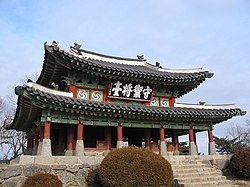Namhansanseong
| Namhansanseong | |
|---|---|
| Name as inscribed on the World Heritage List | |

Sueojangdae (command post)
|
|
| Location | Republic of Korea |
| Type | Cultural |
| Criteria | ii, iv |
| Reference | 1439 |
| UNESCO region | Asia and the Pacific |
| Inscription history | |
| Inscription | 2014 (38th Session) |
| Namhansanseong | |
| Hangul | |
|---|---|
| Hanja | |
| Revised Romanization | Namhansanseong |
| McCune–Reischauer | Namhansansŏng |
Situated 25 km southeast from the center of the capital city of Seoul, the mountain fortress city of Namhansanseong sits approximately 480m above sea level aligning itself with the ridges of the mountain to maximize its defensive capacity. The fortress encompassing 12 km in length protects a vast area utilized as an emergency capital city of the Joseon Dynasty of Korea (1392~1910). With the basis of fortress architecture of East Asia, the fortress embodies the broad exchange between the four countries: Joseon of Korea, Azuchi-Momoyama Period of Japan, Ming and Qing China, especially in the 16th~18th centuries through the continuous wars. The technical development of weaponry and armaments during this period which saw the use of gunpowder in military warfare imported from Europe also greatly influenced the architecture and layout of the fortress. Namhansanseong portrays how the various theories of defense mechanisms in Korea were put to form by combining the everyday living environment with defense objectives, embodies the evidence of how Buddhism played an influential role in protecting the State and the fortress became a symbol of sovereignty in Korea. It stands on the Namhansan ("South Han Mountain"), containing fortifications that date back to the 17th century, and a number of temples. It can be accessed easily from Seoul through Namhansanseong Station of Seoul Subway Line 8.
The most obvious characteristic of Namhansanseong lies in its topographical advantage; a spacious flat top called Gorobong, with a low center and high sides over 480m above sea level, as well as being a high mountain over flat lands to easily observe around. Due to such a topographical advantage, Namhansanseong served as a commanding post since the Unified Silla era in the 7th century. Unified Silla constructed Jujangseong fortress where Namhansanseong sits today, to raise men and to stock supplies when it was carrying out the war against the Tang Dynasty in the 7th century. In the 13th century during Goryeo Dynasty, Namhansanseong was a stronghold against the Mongol Invasion. Since the 17th century, Namhansanseong, near the capital city of Seoul, evolved greatly in its size as a mountain fortress, serving as an emergency capital for the King of Joseon to take refuge in emergencies. Consequently, it became a super-sized mountain fortress, the likeness of which is rarely found anywhere else in the world.
...
Wikipedia
